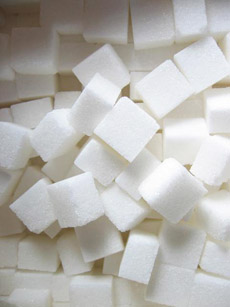Glossary Of Natural & Artificial Non-Caloric SweetenersPage 1: Sweetener Overview This is Page 1 of an 11-page article. Click on the red links below to visit other pages. This glossary is protected by copyright and cannot be reproduced in whole or part. You are welcome to link to it.
|
 No mystery about the white cubed stuff. It’s the dozens of other mysteries in this article that need to be unraveled. Photo courtesy French Byte | MorgueFile. |
|
|
CAPSULE REPORT: Nearly 200 million Americans consume sugar-free or low-calorie products at some point, according to the Calorie Control Council. About half of those are frequent users, consuming an average of four of products every day that contain sugar substitutes, a.k.a. artificial sweeteners, a.k.a. manmade sweeteners. Diet sodas make up 29% of the $70-billion annual U.S. soft drink sales, and the percentage is rising, according to Beverage Digest; other beverages, candy and sweet foods, and even frozen meals contain sugar substitutes. Almost every one has been shown to cause cancer in lab tests, but the data are often flawed. With looming obesity, many people would prefer to take their chances with the non-caloric sweeteners. Here, we provide an overview of nutritive sweeteners, or “real” sugars, and the non-nutritive, artificial sweeteners. This is Page 1 of an 11-page article. Click on the black links below to visit other pages.
A recent U.S. Department of Agriculture (USDA) survey found that the average American consumes the equivalent of 160 pounds of sugar a year—53 heaping teaspoons of sugar a day. This represents a 30 percent increase in consumption over the early 1980s, and is due in large part to sugar additives in so many prepared and processed foods. To learn more, and see shocking visuals of how much sugar is buried in our foods, visit SugarStacks.com.
|
||
|
Sweeteners Overview
“Sweeteners” includes both natural products like cane sugar, honey and molasses, which derive principally from plants or other natural materials; as well as artificial sweeteners made through chemical processes, like aspartame, saccharine and sucralose.
Nutritive (Natural) Sweeteners We’ll begin by taking a look at the nutritive group. |
 Table sugar, or sucrose. Photo by Sanja G. Jenero | SXC. |
|
Last Updated Jun 2018
© Copyright 2005-2025 Lifestyle Direct, Inc. All rights reserved. All images are copyrighted to their respective owners.